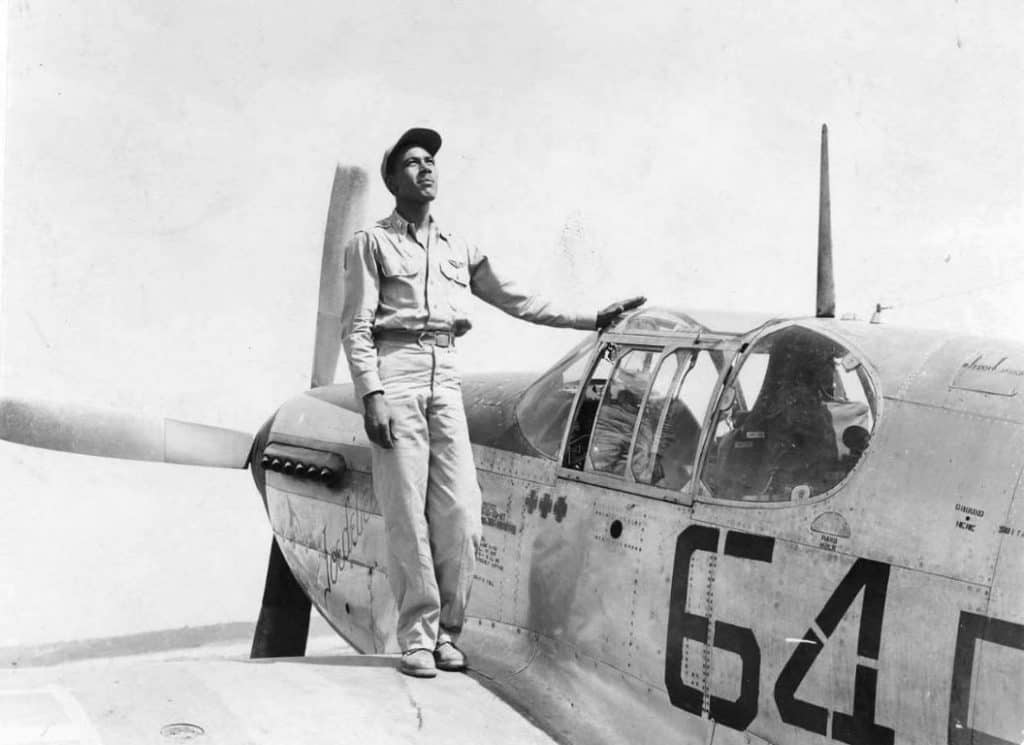
2nd Lt Joseph Elsberry
Class 42-H-SE 9/6/1942 2nd Lt. 0792420 Langston, OK
April 25, 1921 – March 31, 1985
Unit: 301st Fighter Squadron of the 332nd Fighter Group
Elsberry earned the Distinguished Flying Cross by becoming the first black pilot to destroy three enemy aircraft in a single mission on July 12, 1944. After attending his hometown Langston University, Elsberry graduated from the Tuskegee Army Flying School on September 6, 1942, a member of Tuskegee Airmen Class 42-H-SE. He was a gifted pilot who was recognized as one of the most aggressive and fearless members of his unit.
Elsberry’s first major achievement was to lead an attack of P-51 “Mustang” fighter aircraft against an enemy destroyer and sinking it at Trieste Harbor on June 25, 1944. On July 12, Elsberry lead pilots of the Ramitelli, Italy-based 332nd Group on a mission to escort B-17 bombers of the 5th Bombardment Wing to a target in southern France. Through early recognition of the silhouettes of approaching enemy fighters, Elsberry directed a successful interception. During this furious encounter, Elsberry personally destroyed three Focke-Wulf 190 aircraft and was credited with a probable destruction of a fourth Focke-Wulf. When Elsberry was later credited with the destruction of an enemy Messerschmitt 109 aircraft on July 20, 1944 his accomplishments were tantamount to those of an “ace” fighter pilot.
The discipline and aggressiveness shown by Elsberry and his colleagues assigned to protect the bombers resulted in the award of Distinguished Unit Citations to three of the Group’s squadrons, and cemented the legacy of The Tuskegee Airmen. Elsberry received his Distinguished Flying Cross from Brig. General Benjamin Davis Sr. in a September 10, 1944 ceremony that was also attended by Lt. General Ira C. Eaker, Commanding General of the Mediterranean Allied Air Forces, Maj. General Nathan P. Twining, Commanding General of the 15th Air Force, and Brig. General Dean C. Strother, Commanding General of the 306th Fighter Wing of the 15th Air Force.
After the war, Elsberry completed an Air Force career and rose to the rank of Major. He passed away in 1985 and is buried in Arlington National Cemetery.

Class 42-H graduated from flight training on Sept. 6, 1942, at Tuskegee Army Air Field in Alabama. Front row, left to right: Samuel M. Bruce, Wilmore B. Leonard, James L. McCullin, Henry Perry. Back row, left to right: John J. Morgan, Richard C. Caesar, Edward L. Toppins, Robert W. Deiz, Joseph D. Elsberry. (U.S. Air Force Historical Research Agency)
To learn more about the Tuskegee Airmen’s aerial victories, read “112 Victories: Aerial Victory Credits of the Tuskegee Airmen” and “The Tuskegee Airmen in Combat” by Dr. Daniel L. Haulman of the Air Force Historical Research Agency.
Sources:
The CAF Red Tail Squadron is a volunteer-driven organization dedicated to educating audiences across the country about the history and legacy of the Tuskegee Airmen, America’s first black military pilots and their support personnel.






